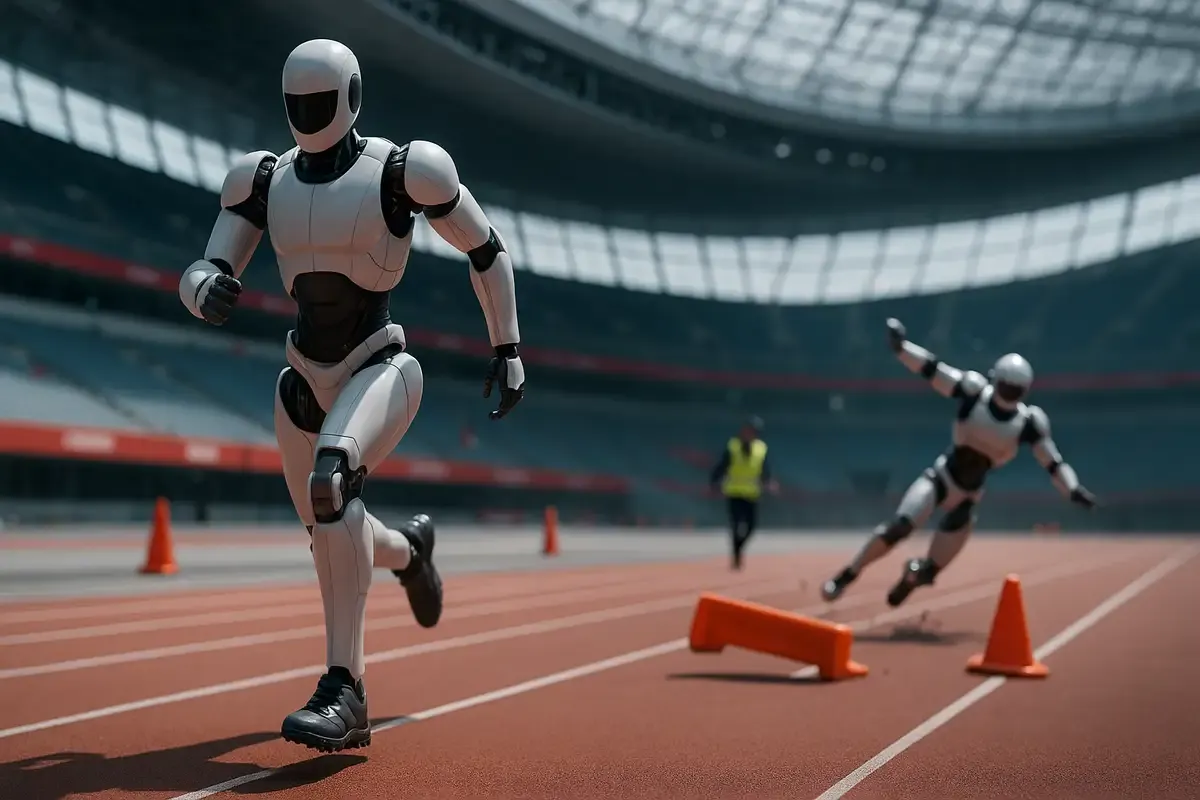💡 TL;DR - The 30 Seconds Version
🏃 China hosted the first World Humanoid Robot Games with 280 teams from 16 countries competing in Beijing over three days in August 2025.
📊 Unitree dominated track events with a 100-meter time of 33.71 seconds—still three times slower than Usain Bolt's 9.58-second human record.
⚽ Soccer robots clustered into chaotic scrums and toppled like dominoes while boxing robots missed stationary targets, revealing current limitations.
💰 The games support China's $139 billion robotics fund announced in March, targeting demographic pressures from rapid population aging.
🌍 International participation created both knowledge sharing and competitive intelligence as US, German, and Brazilian teams competed alongside Chinese groups.
🚀 Progress mirrors industrial robotics development—gradual domain expansion before general-purpose deployment, tempering expectations for household and service robots.
Beijing’s humanoid games doubled as demo day and stress test for a state-backed robotics push.
China just staged the first World Humanoid Robot Games. Records fell, robots did too. The claim was progress; the reality was progress with gravity attached.
More than 280 teams from 16 countries spent three days sprinting, boxing, playing soccer and sorting medicine in Beijing’s National Speed Skating Oval. University labs arrived in force alongside companies such as Unitree and Fournier Intelligence. The field was big. The spectacle was bigger.
What’s actually new
This was the first global meet devoted entirely to human-shaped machines, not rolling carts or factory arms. Events mixed crowd-pleasers—100-meter dashes, five-a-side football—with utilitarian tasks like cleaning and drug categorization. It was a testbed disguised as a tournament. That’s the point.
Unitree cleaned up, winning the 100, 400, 1,500 and the 4x100 relay. One bot ran the 100 in 33.71 seconds, and the fastest 1,500 came in a little over 6:30. Nowhere near human records, but ahead of recent demos.
Evidence, not hype
Speed numbers were only half the story. Stability, balance, and recovery under stress mattered more. One Unitree sprinter stayed upright after colliding with a human official; the person didn’t. In soccer, child-size bots bunched into scrums and toppled like dominoes. A livestream commentator, watching kickboxing robots whiff, offered the driest verdict of the weekend: “The hit rate is a little low.” It was.
Researchers say the bar has moved. Five years ago, seeing a biped reliably walk across rough terrain was headline news. In Beijing, hundreds ran, jumped, and traversed obstacles while others performed service tasks without custom one-off hardware. That shift reflects cheaper platforms and better control stacks. It’s genuine.
The policy backdrop
Beijing isn’t staging this for fun. The government has placed humanoids “at the center of the national strategy,” as trade groups noted last week, and in March unveiled a one-trillion-yuan fund aimed at AI and robotics startups. China already leads on industrial robot installations and is aging fast. The political economy writes the brief: automate to defend growth and reduce dependence on foreign suppliers.
Public contests serve multiple functions in that plan. They recruit talent, benchmark vendors, signal ambition to markets, and surface failure modes early. Open-floor stress tests beat staged showreels. They do now.
Where the tech stands
Humanoids excel when environments are structured and objectives are narrow. Lines are straight, targets predictable, contact forces bounded. They struggle when the world gets messy—flying balls, jostling opponents, slippery footing. That gap is physics plus compute. Humans offload balance, prediction, and micro-adjustments to a lifetime of embodied learning. Robots must calculate each step.
Cognition lags too. Many competitors still depend on human operators for higher-level planning and error recovery. As one academic put it over the weekend: the locomotion is improving; the robots remain “dumb” about goals and context. That bluntness is useful. It keeps expectations in check.
Competitive implications
For China, the weekend signaled a coherent stack strategy: subsidize components, nurture platforms, and amplify via national spectacle. For rivals, the message was mixed. The demos showed real velocity in locomotion and balance. They also advertised how far general-purpose capability remains from commercial service work, elder care, or warehouse chaos.
International participation matters here. U.S., German, and Brazilian teams competed alongside Chinese groups, trading approaches in public. Knowledge flows both ways. So does competitive intelligence. Everyone saw the strengths. Everyone saw the stumbles.
Calibrate the timeline
Expect progress to mirror industrial robots, not smartphones. Capability will expand domain by domain—inspection, logistics, basic indoor delivery—before anything approaching a home generalist. Costs will fall, control policies will harden, and safety envelopes will tighten. Then pilots will scale. Not before.
The weekend’s lesson was humble and healthy. You can’t policy-will physics away. You can, however, organize a nation to chip away at it.
Why this matters
- Industrial policy meets real constraints. China is using spectacle to accelerate a robotics stack, but public stress tests expose the physics, compute, and safety gaps that capital alone can’t erase.
- Expect sober deployment timelines. Humanoids are advancing fast on track and turf, yet still lag on cognition and contact-rich tasks—shaping investment priorities, labor planning, and regulation for years.
❓ Frequently Asked Questions
Q: How fast are these humanoid robots compared to actual human athletes?
A: The fastest robot ran 100 meters in 33.71 seconds versus Usain Bolt's 9.58-second world record. In the 1,500 meters, the winning robot time was 6:34 compared to the human record of 3:26. Robots currently operate at roughly 30% of elite human speed.
Q: Why focus on humanoid robots instead of wheeled or tracked robots that might be more practical?
A: Humanoid robots can navigate environments designed for humans—stairs, doorways, furniture. This makes them suitable for household tasks, elder care, and service work that wheeled robots cannot perform. China's aging population makes this capability strategically important.
Q: What companies besides Unitree participated in the competition?
A: Fournier Intelligence also competed commercially alongside university teams from 16 countries including the US, Germany, and Brazil. The majority of the 280 teams came from academic research labs rather than commercial robotics companies, reflecting the early-stage nature of humanoid technology.
Q: How does China's $139 billion robotics investment compare to other countries?
A: China already leads global industrial robot installations and this fund specifically targets AI and robotics startups. The US lacks a comparable centralized investment program, though private and defense spending remains substantial. The scale reflects China's demographic urgency with rapid population aging.
Q: What practical tasks were the robots tested on besides sports?
A: Robots competed in medicine sorting, cleaning tasks, and material handling—applications directly relevant to healthcare, household work, and logistics. These utilitarian events received less media attention than sports but better represent actual commercial deployment scenarios for humanoid robots.
Q: When will humanoid robots be available for commercial use in homes or businesses?
A: Experts predict domain-by-domain expansion like industrial robotics—starting with inspection, basic logistics, and indoor delivery before general-purpose applications. Current robots still require human operators for complex decision-making, suggesting widespread home deployment remains years away.
Q: What are the main technical challenges holding back humanoid robot development?
A: Physical interaction with dynamic environments requires continuous prediction and real-time adjustment. Humans perform these calculations unconsciously, but robots must compute every movement explicitly. Additionally, higher-level cognitive functions like planning and reasoning lag significantly behind locomotion capabilities.
Q: Did international participation give away Chinese technological secrets or capabilities?
A: The competition created bidirectional intelligence flow. International teams gained insights into Chinese development priorities and capabilities, while China accessed cutting-edge global research and recruited talent. Public stress tests revealed both strengths and limitations to all participants.








